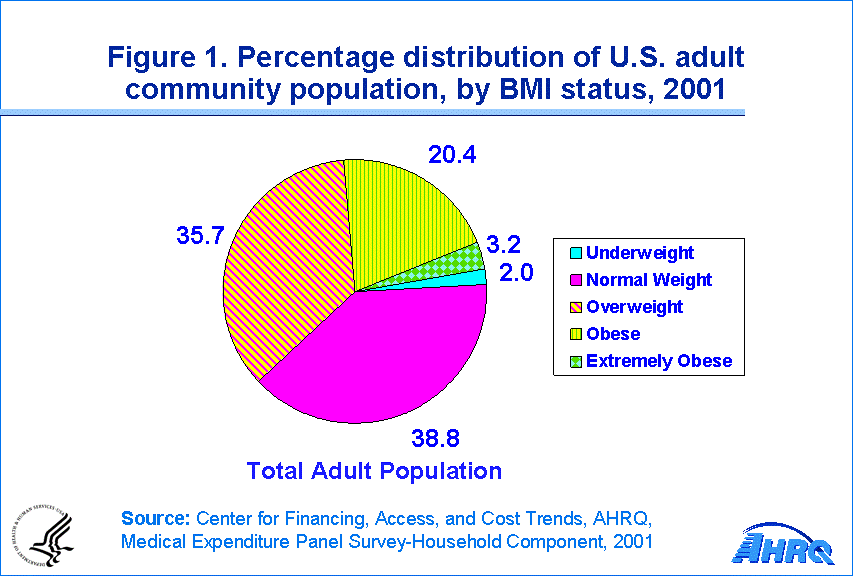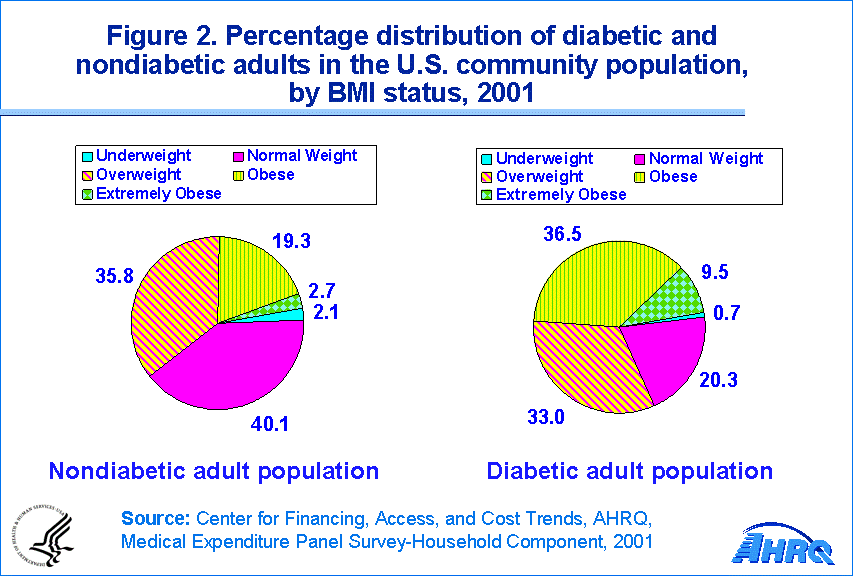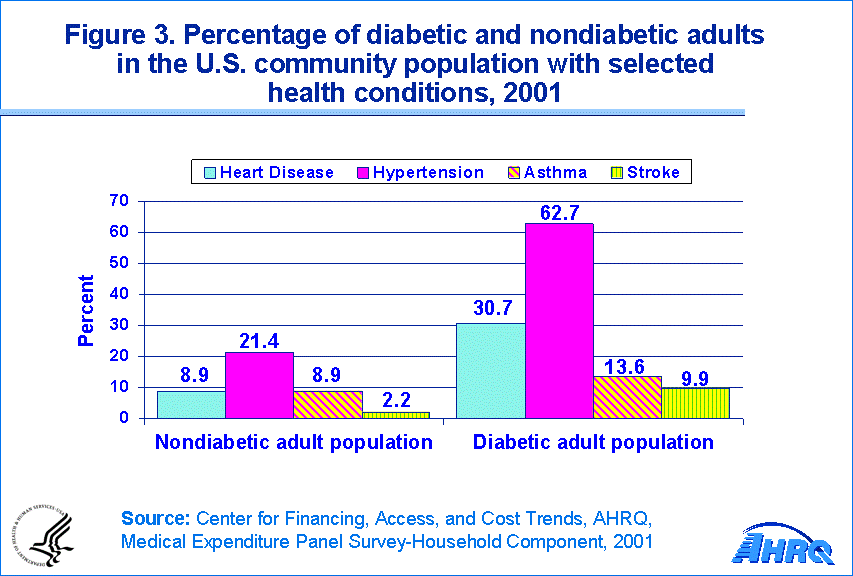
|
|
Font Size:
|
||||
|
|
|
|
||||
STATISTICAL BRIEF #34:
The Prevalence of Obesity and Other Chronic Health Conditions among Diabetic Adults in the U.S. Community Population, 2001
Brief Statement of Findings
- In 2001, over 59 percent of the U.S. adult community population was overweight (BMI of 25.0 to 29.9), obese (BMI of 30.0 to 39.9), or extremely obese (BMI greater than or equal to 40).
- In 2001, adult diabetics were more than three times as likely to be extremely obese than nondiabetic adults and over one and one-half times as likely to be obese.
- In 2001, adult diabetics were more likely than persons not diagnosed with the disease to have asthma and nearly three times as likely to have hypertension.
- In 2001, adult diabetics were over three times as likely to have heart disease and more than four times as likely to have a stroke than persons not reporting the condition.
Introduction
Diabetes is an increasingly prevalent disease in the U.S. community (civilian noninstitutionalized) population. Medical Expenditure Panel Survey Household Component (MEPS-HC) data indicate that, in 2001, about 12.4 million persons of the 207.9 million adults (persons age 18 and older) in the U.S. community population were told by a physician that they had diabetes. In 2000, over $18 billion was spent on health care for persons with diabetes. Medical research has shown that the obesity epidemic is a major contributing factor in the rise in the number of persons with diabetes and other health conditions.
This Statistical Brief presents preliminary estimates of the relationship between diabetes, obesity, and other chronic conditions among adults in the U.S. community population. Body mass index (BMI) was used to categorize people into one of the following weight categories: underweight, normal weight, overweight, obese, and extremely obese. BMI values and categories were based on definitions provided by the National, Lung, Health and Blood Institute of the National Institutes of Health. All results discussed are statistically significant at the 0.05 level.
Discussion
Overall, in 2001 over 59 percent of persons 18 and older in the U.S. community population had BMI associated with weights higher than normal (3.2 percent extremely obese, 20.4 percent obese, and 35.7 percent overweight) (figure 1). Seventy-nine percent of diabetics, compared with 57.8 percent of persons without diabetes, had a BMI of extremely obese, obese, or overweight (figure 2). Diabetics were also more likely to be extremely obese and obese (9.5 percent and 36.5 percent) than nondiabetic adults (2.7 percent and 19.3 percent).
Adult diabetics were more likely than nondiabetics to have reported a number of other chronic health conditions. Diabetics were more likely to have asthma than adult nondiabetics (13.6 percent versus 8.9 percent) (figure 3). Adult diabetics in comparison to nondiabetic adults were nearly three times as likely to have hypertension (62.7 percent versus 21.4 percent), over three times as likely to have heart disease (30.7 percent and 8.9 percent), and over four times as likely to have ever had a stroke (9.9 percent and 2.2 percent).
Data Source
Data concerning the U.S. community population for the year 2001 are derived from the MEPS data files HC-034 and HC-050 and expenditure estimates from the 2000 MEPS Compendium of Tables. The 2001 MEPS-HC had a response rate of about 71.4 percent.
About MEPS-HC
MEPS-HC is a nationally representative longitudinal survey that collects detailed information on health care utilization and expenditures, health insurance, and health status, as well as a wide variety of social, demographic, and economic characteristics for the civilian noninstitutionalized population. It is cosponsored by the Agency for Healthcare Research and Quality (AHRQ) and the National Center for Health Statistics (NCHS).
For a detailed description of the MEPS-HC survey design, sample design, and methods used to minimize sources on nonsampling error, see the following publications:
Cohen, J. Design and Methods of the Medical Expenditure Panel Survey Household Component. MEPS Methodology Report No. 1. AHCPR Pub. No. 97-0026. Rockville, Md.: Agency for Health Care Policy and Research, 1997.
Cohen, S. Sample Design of the 1996 Medical Expenditure Panel Survey Household Component. MEPS Methodology Report No. 2. AHCPR Pub. No. 97-0027. Rockville, Md.: Agency for Health Care Policy and Research, 1997.
These publications and more information about MEPS are available on the MEPS Web site: http://www.meps.ahrq.gov/
References
National Institutes of Health, National Heart, Lung and Blood Institute. Clinical Guidelines on the Identification, Evaluation, and Treatment of Overweight and Obesity in Adults: The Evidence Report. NIH Publication No. 98-4083. Bethesda, Md.: National Institutes of Health, 1998.
 |
||||||||||||||||||||||||||||||
|
||||||||||||||||||||||||||||||
|
|
||||||||||||||||||||||||||||||
 |
||||||||||||||||||||||||||||||
|
||||||||||||||||||||||||||||||
|
|
||||||||||||||||||||||||||||||
 |
||||||||||||||||||||||||||||||
|
||||||||||||||||||||||||||||||
|
|
||||||||||||||||||||||||||||||


